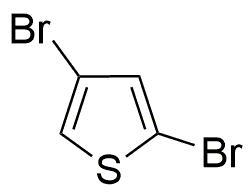2,4-Dibromothiophene is widely utilized in research focused on:
- Organic Electronics: This compound is used in the development of organic semiconductors, which are essential for creating flexible electronic devices like OLEDs (Organic Light Emitting Diodes) and organic solar cells, offering advantages such as lightweight and low-cost production.
- Pharmaceuticals: It serves as an intermediate in the synthesis of various pharmaceuticals, particularly in the creation of compounds with anti-inflammatory and antimicrobial properties, enhancing drug efficacy and safety profiles.
- Material Science: The compound is employed in the production of advanced materials, including conducting polymers, which are crucial for applications in sensors and energy storage devices, providing better conductivity and stability compared to traditional materials.
- Pesticide Development: It is used in the formulation of agrochemicals, particularly in developing herbicides and fungicides, contributing to improved crop yields and pest management while minimizing environmental impact.
- Research and Development: This chemical is a valuable reagent in synthetic organic chemistry, aiding researchers in exploring new chemical reactions and pathways, thus driving innovation in various chemical processes.
General Information
Properties
Safety and Regulations
Applications
2,4-Dibromothiophene is widely utilized in research focused on:
- Organic Electronics: This compound is used in the development of organic semiconductors, which are essential for creating flexible electronic devices like OLEDs (Organic Light Emitting Diodes) and organic solar cells, offering advantages such as lightweight and low-cost production.
- Pharmaceuticals: It serves as an intermediate in the synthesis of various pharmaceuticals, particularly in the creation of compounds with anti-inflammatory and antimicrobial properties, enhancing drug efficacy and safety profiles.
- Material Science: The compound is employed in the production of advanced materials, including conducting polymers, which are crucial for applications in sensors and energy storage devices, providing better conductivity and stability compared to traditional materials.
- Pesticide Development: It is used in the formulation of agrochemicals, particularly in developing herbicides and fungicides, contributing to improved crop yields and pest management while minimizing environmental impact.
- Research and Development: This chemical is a valuable reagent in synthetic organic chemistry, aiding researchers in exploring new chemical reactions and pathways, thus driving innovation in various chemical processes.
Documents
Safety Data Sheets (SDS)
The SDS provides comprehensive safety information on handling, storage, and disposal of the product.
Product Specification (PS)
The PS provides a comprehensive breakdown of the product’s properties, including chemical composition, physical state, purity, and storage requirements. It also details acceptable quality ranges and the product's intended applications.
Certificates of Analysis (COA)
Search for Certificates of Analysis (COA) by entering the products Lot Number. Lot and Batch Numbers can be found on a product’s label following the words ‘Lot’ or ‘Batch’.
*Catalog Number
*Lot Number
Certificates Of Origin (COO)
This COO confirms the country where the product was manufactured, and also details the materials and components used in it and whether it is derived from natural, synthetic, or other specific sources. This certificate may be required for customs, trade, and regulatory compliance.
*Catalog Number
*Lot Number
Safety Data Sheets (SDS)
The SDS provides comprehensive safety information on handling, storage, and disposal of the product.
DownloadProduct Specification (PS)
The PS provides a comprehensive breakdown of the product’s properties, including chemical composition, physical state, purity, and storage requirements. It also details acceptable quality ranges and the product's intended applications.
DownloadCertificates of Analysis (COA)
Search for Certificates of Analysis (COA) by entering the products Lot Number. Lot and Batch Numbers can be found on a product’s label following the words ‘Lot’ or ‘Batch’.
*Catalog Number
*Lot Number
Certificates Of Origin (COO)
This COO confirms the country where the product was manufactured, and also details the materials and components used in it and whether it is derived from natural, synthetic, or other specific sources. This certificate may be required for customs, trade, and regulatory compliance.


